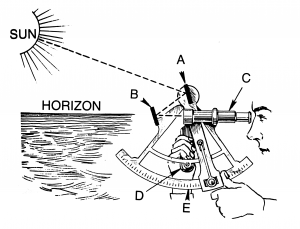 If only we had a GPS for resilience!
If only we had a GPS for resilience!
Today we expect somebody else to tell us where we should be going, how to get there and how we will know when we have arrived.
The journey towards resilience is not that simple.
This picture represents an important tool that early sailors would have needed for navigation. The sextant will tell you where you are currently located but it will not help you decide where you want to go, nor the best way to get there.
This is the second post in the series to outline my focus areas for the blog in 2011. The focus area today is encapsulated by the word “observatory”.
The core idea in this focus area is a desire to be able to measure progress along the journey to resilience.
The observatory thinking flows from the assertion that resilience will require a balance of Art and Science. A statement I will keep coming back to.
Because of this, we are going to have to create some new metrics and innovative tools to measure our observations.
- Firstly because the concept of resilience is not totally and clearly defined to everybody’s agreement
- Secondly, because it is contextual – therefore it will not have exactly the same meaning to every organisation, industry or community, and
- Thirdly, because it is an emergent property.
The first and second point mean that the end state may not be perfectly described, and the third implies we need to measure progress on the journey, not a final output.
The Art & Science of measuring
Douglas Hubbard’s book “How to Measure Anything: Finding the Value of Intangibles in Business“(Affiliate Link) is an interesting place to start since we are attempting to measure intangibles. A more detailed review of this book later in the year.
Two key ideas from Hubbard to give an overview on this focus area;
- we are measuring to reduce uncertainty, not for publication in a scientific journal. There is no need for full scientific rigour.
- in order to make measurements we need to be able to state real problem (or decision) that requires measurement – plus what is it about this problem/decision that needs measurement and to what degree of accuracy.
We will need to select our own tools and techniques from the various disciplines that contribute to resilience, and we will need to adapt these to our specific needs, and perhaps even create some new tools.
Be prepared for some elements of trial and error.
Experimenting with Art & Science
Building resilience into organisations (and people) is rarely a simple activity, more often complicated or complex – and at times down right chaotic!
Back in October I discovered the work of Dave Snowden. His Cynefin model provides an insight into how to deal with complex adaptive systems (such as large organisations). More importantly it promotes an approach we can use where cause and effect are not fully understood.
In only one of the 5 domains is the solution to apply “best practice” – that is where the problem is ‘Simple’.
We need practices (tools and techniques) that represent ‘good’, ’emergent’ and ‘novel’ practice.
Perhaps we will have to create the map vary the mode of travel, as well as define the destination!
I will post a more detailed review of this model shortly, but I expect it will have a significant role to play in this area of focus for the year.
Has any of this whetted your appetite? Not interested? Would love to hear your view either way.
I would be very interested to hear from any readers who have worked with the Cynefin model and tools.
Leave a Reply